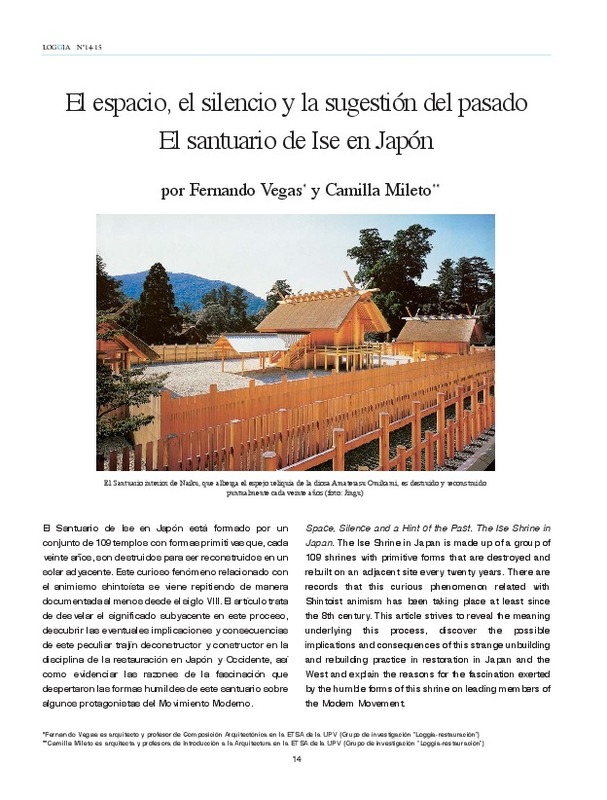JavaScript is disabled for your browser. Some features of this site may not work without it.
Buscar en RiuNet
Listar
Mi cuenta
Estadísticas
Ayuda RiuNet
Admin. UPV
El espacio, el silencio y la sugestión del pasado. El santuario de Ise en Japón
Mostrar el registro sencillo del ítem
Ficheros en el ítem
| dc.contributor.author | Vegas López-Manzanares, Fernando
|
es_ES |
| dc.contributor.author | Mileto, Camilla
|
es_ES |
| dc.coverage.spatial | east=136.72579300000007; north=34.45501; name=Unnamed Road, Ujitachichō, Ise-shi, Mie-ken 516-0023, Japó | es_ES |
| dc.date.accessioned | 2018-10-03T12:12:03Z | |
| dc.date.available | 2018-10-03T12:12:03Z | |
| dc.date.issued | 2003-12-16 | |
| dc.identifier.issn | 1136-758X | |
| dc.identifier.uri | http://hdl.handle.net/10251/109108 | |
| dc.description.abstract | [EN] The Ise Shrine in Japan is made up of a group of 109 shrines with primitive forms that are destroyed and rebuilt on an adjacent site every twenty years. There are records that this curious phenomenon related with Shintoist animism has been taking place at least since the 8th century. This article strives to reveal the meaning underlying this process, discover the possible implications and consequences of this strange unbuilding and rebuilding practice in restoration in Japan and the West and explain the reasons for the fascination exerted by the humble forms of this shrine on leading members of the Modern Movement. | es_ES |
| dc.description.abstract | [ES] El Santuario de Ise en Japón está formado por un conjunto de 109 templos con formas primitivas que, cada veinte años, son destruidos para ser reconstruidos en un solar adyacente. Este curioso fenómeno relacionado con el animismo shintoísta se viene repitiendo de manera documentada al menos desde el siglo VIII. El artículo trata de desvelar el significado subyacente en este proceso, descubrir las eventuales implicaciones y consecuencias de este peculiar trajín deconstructor y constructor en la disciplina de la restauración en Japón y Occidente, así como evidenciar las razones de la fascinación que despertaron las formas humildes de este santuario sobre algunos protagonistas del Movimiento Moderno. | es_ES |
| dc.language | Español | es_ES |
| dc.publisher | Universitat Politècnica de València | |
| dc.relation.ispartof | Loggia, Arquitectura & Restauración | |
| dc.rights | Reconocimiento - No comercial - Sin obra derivada (by-nc-nd) | es_ES |
| dc.subject | Restauración | es_ES |
| dc.subject | Japón | es_ES |
| dc.subject | Santuario | es_ES |
| dc.subject | Restoration | es_ES |
| dc.subject | Japan | es_ES |
| dc.subject | Shrine | es_ES |
| dc.title | El espacio, el silencio y la sugestión del pasado. El santuario de Ise en Japón | es_ES |
| dc.title.alternative | Space, silence and a hint of the past. The Ise Shrine in Japan. | es_ES |
| dc.type | Artículo | es_ES |
| dc.date.updated | 2018-10-03T10:50:40Z | |
| dc.identifier.doi | 10.4995/loggia.2003.3555 | |
| dc.rights.accessRights | Abierto | es_ES |
| dc.contributor.affiliation | Universitat Politècnica de València. Departamento de Composición Arquitectónica - Departament de Composició Arquitectònica | es_ES |
| dc.contributor.affiliation | Universitat Politècnica de València. Centro de Investigación Arquitectura, Patrimonio y Gestión para el Desarrollo Sostenible - Centre d'Investigació Arquitectura, Patrimoni i Gestió per al Desenvolupament Sostenible | es_ES |
| dc.contributor.affiliation | Universitat Politècnica de València. Escuela Técnica Superior de Arquitectura - Escola Tècnica Superior d'Arquitectura | es_ES |
| dc.description.bibliographicCitation | Vegas López-Manzanares, F.; Mileto, C. (2003). El espacio, el silencio y la sugestión del pasado. El santuario de Ise en Japón. Loggia, Arquitectura & Restauración. (14-15):14-41. https://doi.org/10.4995/loggia.2003.3555 | es_ES |
| dc.description.accrualMethod | SWORD | es_ES |
| dc.relation.publisherversion | https://doi.org/10.4995/loggia.2003.3555 | es_ES |
| dc.description.upvformatpinicio | 14 | es_ES |
| dc.description.upvformatpfin | 41 | es_ES |
| dc.type.version | info:eu-repo/semantics/publishedVersion | es_ES |
| dc.description.issue | 14-15 | |
| dc.identifier.eissn | 2444-1619 |








